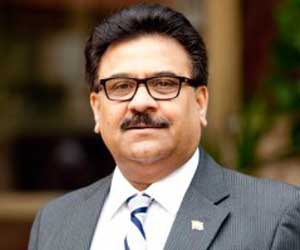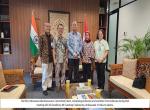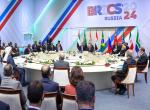En route to UK for the Commonwealth Heads of Government Meeting (CHOGM) Summit, Prime Minister Narendra Modi will be visiting Sweden on April 16 & 17. It will be a bilateral visit, with multilateral engagements, for the first Indo-Nordic Summit at Stockholm at the invitation of PM Stefan Lofven. This will be the first Indian Prime Ministerial visit in three decades. Leaders from Denmark, Finland, Iceland and Norway along with their Swedish host will interact with PM Modi for an in-depth exchange to evolve a concerted action oriented strategy with this important and technologically advanced region, especially in the field of clean technologies, environmental solutions, port modernisation, ship building, food processing, health, agriculture, infrastructure, skill development and innovations, which are the focus areas of India’s development. Nordic Prime Ministers will also have bilateral meetings with the Indian Prime Minister.
Diplomatic ties between India and Sweden were established in 1949. India-Sweden relations have had their chequered history, although presently they have acquired depth, resilience, understanding and mutual respect for individual positions on the international issues. High level contacts between the two countries go back to 1957 when Prime Minister Jawaharlal Nehru visited Sweden. Prime Minister Indira Gandhi visited Sweden for attending the United Nations Conference on the Human Environment in Stockholm in 1972. Prime Minister Rajiv Gandhi also visited Sweden in March 1986 and January 1988. King Gustaf has visited India twice.
During the quest for disarmament, the then Swedish Prime Minister Olof Palme and Rajiv Gandhi had worked closely but Bofors scandal and India’s nuclear tests in 1997 placed the relationship on a backburner - the cool-off period continued for several years. While the rest of Europe and US went ahead exploring India’s immense post-economic reforms potentials, the Swedish leadership kept on mulling the pros and cons of the stance they had taken. Later, realising the futility of a policy of ignoring India, the Swedish Prime Minister Goran Persson decided to revamp the approach with intense engagements to catch up on lost opportunity. His visit and meeting with Prime Minister Vajpayee opened up new vistas of cooperation. Since then several high level visits and exchanges have taken place, the last being that of President Pranab Mukherjee’s in 2016.
The two countries enjoy cordial relationship and excellent cooperation in regional and international fora. Sweden supports India’s membership of the expanded United Nations Security Council (UNSC). Sweden supported India in its membership of the Missile Technology Control Regime (MTCR) and has extended full support in India’s bid for its pending membership of the Nuclear Suppliers Group (NSG). The two countries have been supporting each other on reciprocity for their non-permanent memberships in the UNSC and various positions in different organs of the UN and other multilateral fora. Mutual economic interests have emerged as the driving force in the relationship.
Swedish companies like Swedish Match had come to India in the early 20th Century and major Swedish MNCs like Ericsson, Atlas Copco, ABB, Electrolux, Tetra pack and Volvo and H&M have become household names. Ikea is the latest entrant although for decades they have been sourcing billions of dollars of products from India for their global stores. Sweden has emerged as India's valued partner in trade, technology and investment. Over 170 Swedish companies have invested USD 1.4 billion since 2000. Around 70 Indian companies have invested in Sweden. India-Sweden annual bilateral trade stands at around USD 1.8 billion which is indeed way below potential. Defence is an important area for closer engagement as despite the Bofors scandal and Swedish companies are keen to enter the market in a significant way. They are hoping to sell Grippen - their single engine ace fighter aircraft. Sweden-India Business Council has been actively promoting the economic exchanges.
PM Lofven last visited India in February 2016 along with a large business delegation for participating in ‘Make in India’ event in Mumbai and the ‘Vibrant Gujarat’ in Ahmedabad. Large number of ministerial delegations have visited from both sides in the intervening period. Apart from the Sweden India Business Council that has been in existence since 2002 and one was fortunate to be involved since its institution has become the coordinating agency for the India -Sweden Business Leaders Round Table (ISBLRT), created in February 2016 with Confederation of Indian Industry (CII). Meetings have been held in New Delhi on 9 November 2016 and second meeting in Stockholm on 11 October 2017. Prime Minister Modi will be addressing the Swedish industry and Sweden Business is slated to line up the top CEOs for this very important interaction where India’s exceptional potential and Swedish cutting edge technologies and capital will be leveraged for the benefit of both sides. Greater efforts have to be made to even reach the already agreed $5bn trade target (by 2018) since it is way behind schedule and expectations.
Prime Minister Modi will also be addressing the Indian community from Sweden and other Nordic countries and there is tremendous enthusiasm among the Indian diaspora in the Nordic region. The Indian community of over 25000 in Sweden alone has lived and assimilated with local culture and ethos and mostly comprises of successful professionals .In order to strengthen people-to-people and cultural exchanges several regular events and mechanisms are in place.
During the visit of President Mukherjee in 2015, six inter-governmental Agreements/MOUs were signed, which dealt with important areas of cooperation i.e., Sustainable Urban Development; Micro, Small and Medium Enterprises; Visa Exemption for Diplomatic Passports; Polar and Ocean Research; Ageing and Health; and Pharmaceutical products. Since Sweden can boast of some of the finest educational and research institutions and is one of the ace spenders on R&D globally, fifteen agreements were also signed between the educational institutions of the two countries. In addition the Inter-governmental Joint Commission on Economic, Industrial and Scientific cooperation as well as the Joint Working Group on Defence Cooperation and Foreign Office Dialogue are the key mechanisms to orient and take stock of the cooperation. But usually, such mechanisms have a petering out of enthusiasm and become repetitive with merely recommendatory statements which are again assesses during the next meeting. Hence it is important to have a Joint Plan of Action with time bound deadlines. In addition, during the visit we may see closer cooperation or agreement on an Innovation Partnership as this is a focus in India and an expertise of Sweden and other Nordic countries.
Likewise, our relations with other countries like Denmark, Finland, Iceland and Norway have been expanding, but these do need a fillip and focus since the current levels are way below potential. India’s trade with the Nordic countries is around USD 5.3 billion in 2016-17 and Cumulative Foreign Direct Investment (FDI) to India is USD 2.5 billion. Norway has the largest future/pension funds to the tune of US$ one trillion managed by Government Pension Fund Global (GPFG), some of which could be gainfully deployed in Indian markets, industry and technological ventures that could provide excellent returns given the resurgence and growth of Indian economy and opportunity. The Nordic countries have globally recognized strengths in clean technologies, environmental solutions, port modernisation, food processing, health, agriculture infrastructure, skill development and innovation which are also the focus areas of India’s development. These complementarities and the unique strengths of India and the Nordic countries hold the potential to further boost trade and investment from both sides.
Hopefully the Indo-Nordic Summit will devise a mechanism to address the core concerns, if any, especially through predictability of the policy, its longevity and outcomes which India under the current regime has effectively addressed. We could also work with them in third countries and continents like in Africa, perhaps in the ambit of the Asia Africa Growth Corridor (AAGC), where their Aid agencies have already been quite active. In the 1980’s, when we became member of the African Development Bank (AfDB) in Abidjan, we were part of the Nordic constituency and that worked very well for us. This could emerge as a truly 21st Century partnership given the technological slant and institutional and industrial depth in the Nordic countries.
(The author is a former Ambassador, and a Distinguished Fellow at the Vivekananda International Foundation, New Delhi)
(Views expressed are of the author and do not necessarily reflect the views of the VIF)
Image Source: http://fabulousbydesign.net/wp-content/uploads/2017/12/map-of-northern-europe-countries-and-capitals-1-maps-update-881740-with-resolution-881x740.jpg











Post new comment